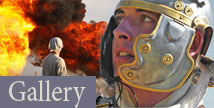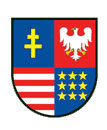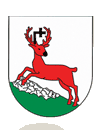In 1990s there were some changes in the scientific environment conducting research on metallurgy in the Świętokrzystkie region. For a long time the works were supervised by prof. Kazimierz Bielenin (Bielenin 2002, 2006) and also today scientists from the Academy of Mining and Metallurgy [1] participate in them. However, for the last 20 years the field research and cooperation with metallurgists has been continued by a local group of archeologists [2] who initiated the creation of the Świetokrzyskie Association of Industrial Heritage partly referring to the activity of Society for Mining, Metallurgy and Old Polish Industry Friendship – the organizer of the ‘Dymarki’ festival in the years 1970-1997.

Research on a slag-pit furnace plan conducted in 2010 by Dr. Szymon Orzechowski on the ‘Wykus’ reserve.
In 1971 the Society for Mining, Metallurgy and Old Polish Industry Friendship purchased the land where the archaeological festival was organised and later built there the infrastructure which was used during the event for many years to come. Due to financial problems within the Society in late 1990s the property was sold to private owners. Earlier the local council tried to communalize the estate which advanced Society’s decision to sell the land. In 1998 the archaeological event’s organization was taken over by the Nowa Słupia district council. The Society focused then on the preparation of the iron casting demonstration. The fact that it was the local council which became responsible for the event did not improve the financial condition of the society and thus in January 1999 its active operation came to an end. Former members and some people from outside of the society created the already mentioned Świetokrzyskie Association of the Industrial Heritage in April 1999. ‘Dymarki Świętokrzyskie’ archaeological festival is still connected with scientific research, experimental work and demonstrations by people from outside of the local community though the local council strongly identifies itself with the brand of the event and its traditions i.e. by building the infrastructure for the presentations from their own as well as EU funds (the Świętokrzyskie Center of Experimental Archaeology). Popularizing research results on ancient metallurgy in the region belongs to the people conducting the works themselves (Metallurgy in the Świętokrzyskie region..; In a blacksmith’s shop from the Świętokrzyskie region …; 50 years of research …; Orzechowski and others 2008) so the form seems truthful to the reconstructed sources [3] with no place for misinterpretation. The form of presentation evolved itself- from the demonstration of the scientific experiments’ effects to the presentation including a wider archaeological and historical context referring directly to the realities of the ancient everyday life.
[1] PhD Eng. Mirosław Karbowniczek, Dr. Eng. Ireneusz Suliga (compare Suliga, Karbowniczek, Góra, Orzechowski 2002; Karbowniczek 2006; Suliga 2006). Prof. Kazimierz Bielenien died on 1th Nov 2011.
[2] At present archaeological research on various aspects of ancient metallurgy in the Świętokrzyskie region is conducted by: Szymon Orzechowski, Andrzej Przychodni, Daniel Czernek, Adrian Wrona, Urszula and Artur Jedynak as well as Kamil Kaptur.
[3] It is worth noting at this point that relying on the accuracy of archaeological sources is proportional to the condition of the source base selected for interpretation.











